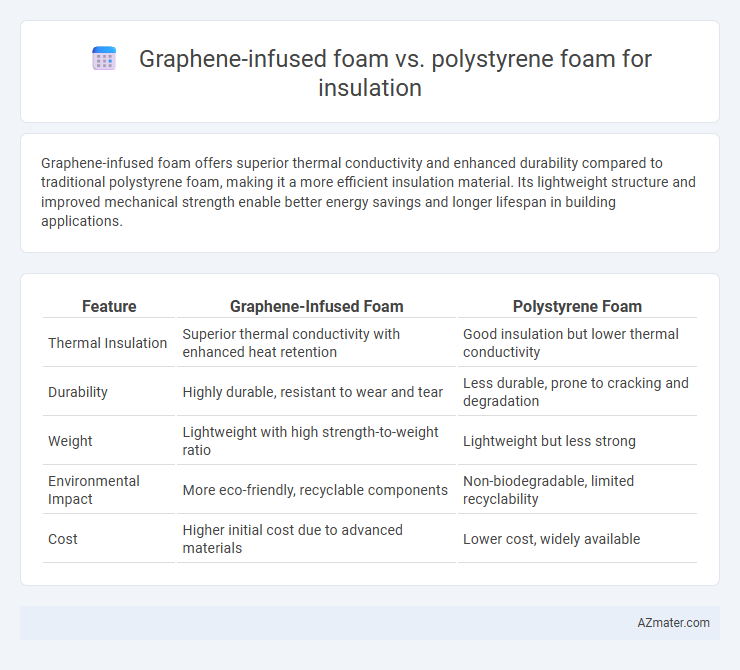Graphene-infused foam offers superior thermal conductivity and enhanced durability compared to traditional polystyrene foam, making it a more efficient insulation material. Its lightweight structure and improved mechanical strength enable better energy savings and longer lifespan in building applications.
Table of Comparison
| Feature | Graphene-Infused Foam | Polystyrene Foam |
|---|---|---|
| Thermal Insulation | Superior thermal conductivity with enhanced heat retention | Good insulation but lower thermal conductivity |
| Durability | Highly durable, resistant to wear and tear | Less durable, prone to cracking and degradation |
| Weight | Lightweight with high strength-to-weight ratio | Lightweight but less strong |
| Environmental Impact | More eco-friendly, recyclable components | Non-biodegradable, limited recyclability |
| Cost | Higher initial cost due to advanced materials | Lower cost, widely available |
Introduction to Advanced Foam Insulation Materials
Graphene-infused foam offers enhanced thermal conductivity and superior mechanical strength compared to traditional polystyrene foam, making it a breakthrough in advanced insulation materials. Polystyrene foam, widely used for its lightweight and cost-effectiveness, lacks the durability and thermal efficiency provided by graphene infusion. The integration of graphene significantly improves heat retention and impact resistance, positioning graphene-infused foam as a more sustainable and high-performance alternative in insulation technology.
Overview of Graphene-Infused Foam Technology
Graphene-infused foam leverages the exceptional thermal conductivity and mechanical strength of graphene to enhance insulation performance beyond traditional materials. This technology incorporates graphene nanoparticles within the foam matrix, resulting in improved durability, reduced thermal bridging, and increased energy efficiency. Compared to polystyrene foam, graphene-infused foam offers superior thermal insulation, higher compressive strength, and greater fire resistance, positioning it as an advanced solution for building insulation and industrial applications.
Properties and Characteristics of Polystyrene Foam
Polystyrene foam, widely used in insulation, is known for its lightweight structure, excellent moisture resistance, and high thermal insulation values, typically with an R-value of around 4 to 5 per inch. Its closed-cell structure provides durability and resistance to compression, making it suitable for building envelopes and insulation panels. However, polystyrene foam lacks the enhanced thermal conductivity and mechanical strength observed in graphene-infused foam composites, limiting its performance in advanced insulation applications.
Thermal Conductivity: Graphene-Infused vs Polystyrene Foam
Graphene-infused foam exhibits significantly lower thermal conductivity compared to traditional polystyrene foam, enhancing insulation efficiency by reducing heat transfer. The integration of graphene's exceptional thermal properties creates a more effective barrier against temperature fluctuations, making it ideal for advanced insulation applications. Polystyrene foam, while widely used, typically has higher thermal conductivity, resulting in less effective thermal resistance than graphene-enhanced alternatives.
Mechanical Strength and Durability Comparison
Graphene-infused foam exhibits significantly higher mechanical strength and durability compared to traditional polystyrene foam, due to graphene's exceptional tensile strength and rigidity. This enhances the foam's resistance to compression, impact, and wear, extending the lifespan of insulation materials in both residential and industrial applications. Polystyrene foam, while lightweight and cost-effective, tends to degrade faster under mechanical stress and environmental exposure, making graphene-infused foam a superior choice for long-term insulation performance.
Environmental Impact and Sustainability Considerations
Graphene-infused foam offers enhanced insulation efficiency while requiring fewer raw materials, resulting in a lower carbon footprint compared to traditional polystyrene foam, which is derived from petroleum and is non-biodegradable. The production of graphene-enhanced insulation materials typically consumes less energy and generates less hazardous waste, contributing to improved sustainability profiles. Polystyrene foam poses significant environmental challenges due to its persistence in landfills and potential to release toxic chemicals during degradation, making graphene-infused foam a more environmentally responsible choice for green building applications.
Fire Resistance and Safety Features
Graphene-infused foam offers superior fire resistance compared to traditional polystyrene foam due to its enhanced thermal stability and ability to inhibit flame spread. Unlike polystyrene foam, which is highly flammable and releases toxic smoke when burned, graphene-infused foam provides improved safety by reducing smoke emissions and slowing combustion rates. These safety features make graphene-infused foam a preferable choice for insulation applications requiring higher fire protection standards.
Moisture Resistance and Mold Prevention
Graphene-infused foam demonstrates superior moisture resistance compared to traditional polystyrene foam, significantly reducing water absorption and preventing the growth of mold and mildew in insulation applications. Its enhanced hydrophobic properties and antimicrobial surface inhibit mold formation, extending the material's lifespan and maintaining indoor air quality. Polystyrene foam, while effective for thermal insulation, is more prone to moisture retention and mold susceptibility, making graphene-infused foam a more durable and hygienic choice for damp environments.
Cost Analysis and Market Availability
Graphene-infused foam offers superior thermal insulation and durability compared to traditional polystyrene foam but comes at a higher initial cost due to advanced manufacturing processes and limited production scale. Polystyrene foam remains widely available and economical, dominating the insulation market because of its low price and established supply chains. While graphene-enhanced foam shows potential for long-term energy savings, current market availability is restricted, impacting its cost competitiveness against polystyrene in large-scale applications.
Future Trends in Foam Insulation Technologies
Graphene-infused foam is emerging as a revolutionary material in insulation due to its superior thermal conductivity and mechanical strength compared to traditional polystyrene foam, which is widely used for its cost-effectiveness and ease of manufacturing. Future trends indicate a growing shift towards graphene-enhanced composites that improve energy efficiency by reducing thermal bridging and enhancing durability, addressing the limitations of polystyrene such as degradation under UV exposure and lower insulation performance at extreme temperatures. Research and development efforts focus on scalable production techniques for graphene-infused foams, aligning with increasing regulatory demands for sustainable and high-performance building materials in the global insulation market.

Infographic: Graphene-infused foam vs Polystyrene foam for Insulation
 azmater.com
azmater.com